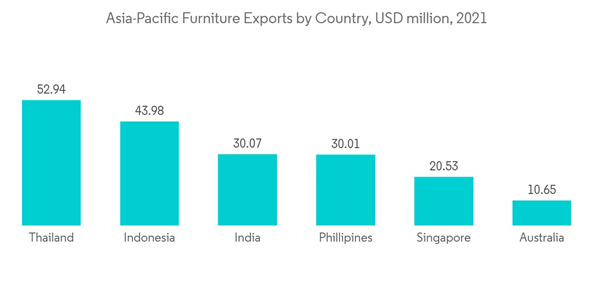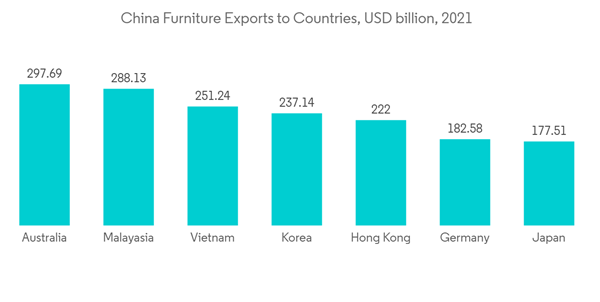In the Asia-Pacific region, the COVID-19 pandemic has significantly impacted the particle board sector. Particle board production and sales have decreased on account of supply chain disruption, decreased consumer expenditure, and rising raw material costs.
Key Highlights
- On the other hand, the pandemic has also presented some opportunities for the Asia-Pacific region's particle board business. Due to the move to work remotely and an increase in building activities, the demand for particle board goods has increased in 2021, which has raised the need for home office furniture.
- The rising demand for affordable furniture, along with a rise in per-capita disposable income, is expected to drive market growth.
- However, stringent environmental restrictions and high raw material costs have hindered the market expansion.
- Nevertheless, it is projected that innovative materials and modern production methods are expected to support market expansion in the future.
- China is anticipated to lead the Asia-Pacific region in terms of revenue during the expected timeframe.
Asia-Pacific Particle Board Market Trends
Growing Demand from the Furniture Industry
- Rising population and changes in consumer lifestyle have had a significant impact on the recent shift in furniture style preferences. Particle boards that have been laminated may feature wood veneers or decorative plastic laminates. When compared to regular, unfinished fiberboards, particle boards are stronger, smoother, and more attractive. Additionally, they are simple to maintain and clean.
- There is a rise in the demand for new office construction, as there is an increase in the demand for flooring underlayment, cubical partitioning, wall paneling, false ceiling, doors, and furniture. Additionally, it is predicted that remodeling and refurbishing the already existing office buildings would help to meet the anticipated increase in product demand.
- There has been an increase in startups and new office spaces in India, with over 80,000 new startups and a valuation of USD 36.42 billion in 2022, according to the India Brand Equity Foundation (IBEF). Additionally, over 40 startups are anticipated to reach a valuation of USD 1 billion within the next two years.
- China exported furniture worth USD 6.21 billion more than any other country in the world in 2021, according to the World Bank. Malaysia exports around 80% of furniture production. Malaysia exports furniture to the United Kingdom, Saudi Arabia, the United Arab Emirates, Russia, and the Philippines. In addition, support from the Malaysian government for the development of the furniture industry through various strategic initiatives to ensure its sustainable and rapid growth is expected to augment the market growth.
- Overall, it is expected that the rising furniture sector throughout the region is expected to drive the particle board market throughout the projected period.
China is Anticipated to Hold a Major Share
- The demand for particle boards in China is being driven by the exponential growth of the furniture and building sectors. In the building sector, particle boards are used for stairways, walls, and flooring, among other things.
- China's five-year plan, which was released in January 2022, projected that the country's construction industry would rise by about 6% in 2022. China intends to promote the production of prefabricated structures to reduce waste and pollution from construction sites.
- Furthermore, according to the National Development and Reform Commission, the Chinese government approved 26 infrastructure projects worth USD 142 billion in 2019, with construction already underway and completion anticipated in 2023.
- Nearly 40% of the furniture produced worldwide comes from Chinese furniture manufacturing companies. Due to its large population, furniture is in extremely high demand in China. Due to the country's large population and expanding disposable income, people are prepared to spend more money on furniture and floor coverings in China.
- Interior design ideas for homes, offices, and apartments are always evolving in the furniture market. In terms of designs, sizes, and colors, this is essentially driving innovation and progress. As a result, the volume of furniture production is expected to grow.
- China will be the biggest exporter of furniture to the United States in 2021, shipping around USD 1,165.7 million and the second-largest exporter of Chinese furniture to South Africa, with USD 319.89 million.
- Considering all the above-mentioned factors, the increase in the demand for particle board in China is anticipated to expand during the forecast period.
Asia-Pacific Particle Board Market Competitor Analysis
The Asia-Pacific particle board market is partially consolidated in nature. Some of the major players in the market include Bangkok Master Wood Co. Ltd, CenturyPly, Fletcher Building, Foshan Jujian Yifang Trading Co. Ltd, Green River Holding Co. Ltd, and others.Additional benefits of purchasing the report:
- The market estimate (ME) sheet in Excel format
- 3 months of analyst support
This product will be delivered within 2 business days.
Table of Contents
1 INTRODUCTION1.1 Study Assumptions
1.2 Scope of the Study
2 RESEARCH METHODOLOGY
3 EXECUTIVE SUMMARY
4 MARKET DYNAMICS
4.1 Drivers
4.1.1 Increasing Demand from the Furniture Industry
4.1.2 Easy Availability of Raw Materials
4.2 Restraints
4.2.1 Threat of Medium-density Fiberboard as a Substitute
4.3 Industry Value-Chain Analysis
4.4 Porter's Five Forces Analysis
4.4.1 Bargaining Power of Suppliers
4.4.2 Bargaining Power of Buyers
4.4.3 Threat of New Entrants
4.4.4 Threat of Substitute Products and Services
4.4.5 Degree of Competition
5 MARKET SEGMENTATION
5.1 By Raw Material
5.1.1 Wood
5.1.1.1 Sawdust
5.1.1.2 Shavings
5.1.1.3 Flakes
5.1.1.4 Chips
5.1.2 Bagasse
5.1.3 Other Raw Materials
5.2 By Application
5.2.1 Construction
5.2.2 Furniture
5.2.3 Infrastructure
5.2.4 Other Applications
5.3 By Geography
5.3.1 China
5.3.2 India
5.3.3 Japan
5.3.4 South Korea
5.3.5 Rest of Asia-Pacific
6 COMPETITIVE LANDSCAPE
6.1 Mergers, Acquisitions, Joint Ventures, Collaborations, and Agreements
6.2 Market Share (%)**/Ranking Analysis
6.3 Strategies Adopted by the Leading Players
6.4 Company Profiles
6.4.1 Bangkok Master Wood Co. Ltd
6.4.2 CenturyPly
6.4.3 Fletcher Building
6.4.4 Foshan Jujian Yifang Trading Co. Ltd
6.4.5 Green River Holding Co. Ltd
6.4.6 Greenlam Industries Ltd
6.4.7 Jiangmen Changda Wood Products Co. Ltd
6.4.8 Metro Particle Co. Ltd
6.4.9 Panel Plus Co. Ltd
6.4.10 ONP-Vietnam LLC
6.4.11 Shandong National Forest Products Co. Ltd
6.4.12 Shirdi Industries Limited
6.4.13 Wisewoods Co. Ltd
6.4.14 Wanhua Ecoboard Co. Ltd
7 MARKET OPPORTUNITIES AND FUTURE TRENDS
7.1 Development of New Methods to Manufacture Particle Boards
Companies Mentioned (Partial List)
A selection of companies mentioned in this report includes, but is not limited to:
- Bangkok Master Wood Co. Ltd
- CenturyPly
- Fletcher Building
- Foshan Jujian Yifang Trading Co. Ltd
- Green River Holding Co. Ltd
- Greenlam Industries Ltd
- Jiangmen Changda Wood Products Co. Ltd
- Metro Particle Co. Ltd
- Panel Plus Co. Ltd
- ONP-Vietnam LLC
- Shandong National Forest Products Co. Ltd
- Shirdi Industries Limited
- Wisewoods Co. Ltd
- Wanhua Ecoboard Co. Ltd










